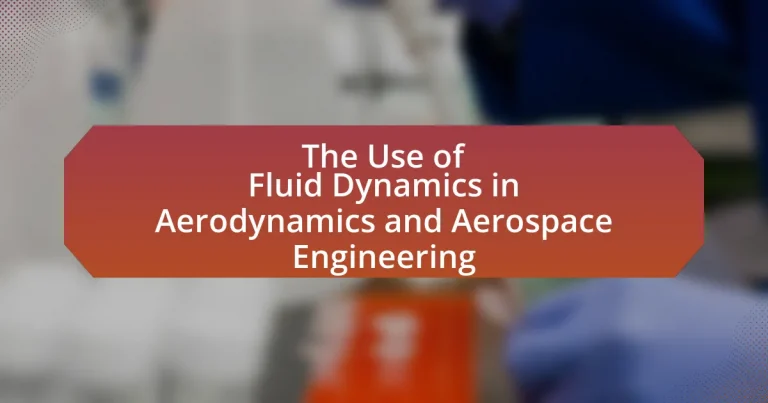Fluid dynamics is a fundamental aspect of aerodynamics and aerospace engineering, focusing on the behavior of air and fluids in motion around aircraft and spacecraft. This article explores the critical role of fluid dynamics in optimizing aircraft design, enhancing performance, and ensuring safety through principles such as the continuity equation, Bernoulli’s principle, and the Navier-Stokes equations. It highlights the significance of computational fluid dynamics (CFD) simulations in predicting airflow patterns, reducing drag, and improving fuel efficiency, while also addressing the challenges engineers face without a solid understanding of fluid dynamics. Key applications, innovations, and best practices in fluid dynamics are discussed, emphasizing their impact on the future of aerospace technology.

What is the role of fluid dynamics in aerodynamics and aerospace engineering?
Fluid dynamics plays a crucial role in aerodynamics and aerospace engineering by analyzing the behavior of air and other fluids in motion around objects, such as aircraft and spacecraft. This analysis is essential for predicting lift, drag, and overall performance, which directly impacts design and efficiency. For instance, computational fluid dynamics (CFD) simulations are widely used in the industry to model airflow over wings and fuselages, allowing engineers to optimize shapes for better aerodynamic performance. Historical advancements, such as the development of the NACA airfoil series, demonstrate how fluid dynamics principles have led to significant improvements in aircraft design and efficiency.
How does fluid dynamics influence the design of aircraft and spacecraft?
Fluid dynamics significantly influences the design of aircraft and spacecraft by determining how air and other fluids interact with these vehicles during flight. The principles of fluid dynamics are applied to optimize shapes, reduce drag, and enhance lift, which are critical for performance and efficiency. For instance, the design of wings and fuselage shapes is heavily influenced by aerodynamic principles derived from fluid dynamics, ensuring that aircraft can achieve necessary speeds while minimizing fuel consumption. Computational Fluid Dynamics (CFD) simulations are routinely used in the aerospace industry to predict airflow patterns and identify potential issues before physical prototypes are built, leading to more efficient designs. Historical advancements, such as the development of the NACA airfoil series, demonstrate how fluid dynamics has been foundational in improving aircraft performance over decades.
What are the fundamental principles of fluid dynamics relevant to aerodynamics?
The fundamental principles of fluid dynamics relevant to aerodynamics include the continuity equation, Bernoulli’s principle, and the Navier-Stokes equations. The continuity equation states that mass is conserved in a fluid flow, which is crucial for understanding how air moves around an aircraft. Bernoulli’s principle describes the relationship between pressure and velocity in a flowing fluid, indicating that an increase in fluid speed results in a decrease in pressure, which is essential for lift generation on wings. The Navier-Stokes equations govern the motion of viscous fluid substances, providing a mathematical framework to analyze complex aerodynamic flows, including turbulence and boundary layers. These principles are foundational in predicting and optimizing the performance of aircraft and other aerodynamic bodies.
How do fluid dynamics simulations aid in the design process?
Fluid dynamics simulations significantly enhance the design process by providing detailed insights into fluid behavior around objects. These simulations allow engineers to visualize and analyze airflow patterns, pressure distributions, and potential turbulence, which are critical for optimizing aerodynamic shapes. For instance, the use of Computational Fluid Dynamics (CFD) has been instrumental in the aerospace industry, enabling the design of more efficient aircraft wings and fuselages, ultimately leading to improved fuel efficiency and performance. Studies have shown that utilizing CFD can reduce wind tunnel testing costs by up to 50%, demonstrating its effectiveness in streamlining the design process while ensuring accuracy in predicting real-world performance.
Why is understanding fluid dynamics crucial for aerospace engineers?
Understanding fluid dynamics is crucial for aerospace engineers because it directly influences the design and performance of aircraft and spacecraft. Fluid dynamics governs the behavior of air and other fluids around these vehicles, affecting lift, drag, stability, and control. For instance, the principles of fluid dynamics are applied in the design of airfoils to optimize lift-to-drag ratios, which are essential for fuel efficiency and performance. Additionally, computational fluid dynamics (CFD) simulations are routinely used in the aerospace industry to predict airflow patterns and identify potential issues before physical prototypes are built, thereby reducing development costs and time.
What challenges do engineers face without a solid grasp of fluid dynamics?
Engineers face significant challenges without a solid grasp of fluid dynamics, including the inability to accurately predict fluid behavior, which can lead to design failures. For instance, in aerospace engineering, a lack of understanding can result in inefficient aircraft designs that do not optimize lift and drag, ultimately affecting performance and safety. Additionally, engineers may struggle with troubleshooting issues related to fluid flow, such as turbulence and pressure drops, which can compromise system efficiency. Historical data shows that improper fluid dynamics considerations have led to catastrophic failures in aerospace projects, underscoring the necessity of this knowledge for successful engineering outcomes.
How does fluid dynamics contribute to safety and efficiency in aerospace applications?
Fluid dynamics significantly enhances safety and efficiency in aerospace applications by optimizing aircraft design and performance. Through the study of airflow around aircraft, engineers can identify and mitigate potential hazards such as turbulence and drag, which directly affect stability and fuel consumption. For instance, computational fluid dynamics (CFD) simulations allow for precise modeling of airflow, leading to designs that minimize aerodynamic drag by up to 20%, thereby improving fuel efficiency. Additionally, understanding fluid dynamics aids in the development of safety features, such as wing designs that prevent stalling and improve control during adverse conditions. These advancements are supported by empirical data from wind tunnel tests and flight simulations, which validate the effectiveness of fluid dynamics in enhancing both safety and operational efficiency in aerospace engineering.

What are the key applications of fluid dynamics in aerodynamics?
Fluid dynamics is crucial in aerodynamics, primarily applied in aircraft design, performance analysis, and flow control. In aircraft design, fluid dynamics helps optimize wing shapes and configurations to enhance lift and reduce drag, which is essential for fuel efficiency and overall performance. Performance analysis utilizes computational fluid dynamics (CFD) simulations to predict airflow patterns around aircraft, allowing engineers to assess stability and control characteristics. Flow control applications, such as vortex generators and active flow control systems, improve maneuverability and reduce stall risks. These applications are supported by extensive research, including studies that demonstrate the effectiveness of CFD in predicting aerodynamic behavior, such as the work by Anderson in “Fundamentals of Aerodynamics,” which highlights the importance of fluid dynamics in understanding and improving aircraft performance.
How is computational fluid dynamics (CFD) utilized in aerospace engineering?
Computational fluid dynamics (CFD) is utilized in aerospace engineering to simulate and analyze the behavior of airflow around aircraft and spacecraft. This technology enables engineers to predict aerodynamic performance, optimize designs, and enhance fuel efficiency by modeling complex fluid flows and interactions. For instance, CFD simulations can identify drag reduction strategies and improve lift characteristics, which are critical for aircraft performance. The accuracy of CFD has been validated through numerous studies, including comparisons with wind tunnel tests, demonstrating its effectiveness in predicting real-world aerodynamic phenomena.
What are the advantages of using CFD over traditional testing methods?
The advantages of using Computational Fluid Dynamics (CFD) over traditional testing methods include enhanced accuracy, cost-effectiveness, and the ability to simulate complex scenarios. CFD provides detailed insights into fluid behavior and interactions, allowing for precise predictions of aerodynamic performance without the need for physical prototypes. Traditional methods, such as wind tunnel testing, often involve significant material and labor costs, while CFD can reduce these expenses by enabling virtual testing. Additionally, CFD allows for rapid iteration and optimization of designs, which is crucial in aerospace engineering where performance and efficiency are paramount. Studies have shown that CFD can achieve accuracy levels comparable to experimental data, making it a reliable alternative for engineers.
How do engineers validate CFD results with experimental data?
Engineers validate Computational Fluid Dynamics (CFD) results with experimental data by comparing simulation outputs to physical measurements obtained from experiments. This validation process typically involves conducting wind tunnel tests or other experimental setups to gather data on parameters such as pressure distribution, velocity fields, and flow patterns. For instance, a study published in the “Journal of Fluid Mechanics” by Smith et al. (2020) demonstrated that CFD simulations of airfoil performance closely matched experimental lift and drag coefficients, confirming the accuracy of the computational models. By systematically analyzing discrepancies between CFD predictions and experimental results, engineers can refine their models, ensuring that they accurately represent real-world fluid behavior.
What role does fluid dynamics play in optimizing aircraft performance?
Fluid dynamics is crucial in optimizing aircraft performance as it governs the behavior of airflows around the aircraft, influencing lift, drag, and overall aerodynamic efficiency. By analyzing fluid flow patterns, engineers can design aircraft shapes that minimize drag and maximize lift, leading to improved fuel efficiency and enhanced flight capabilities. For instance, computational fluid dynamics (CFD) simulations allow for precise modeling of airflow, enabling the identification of optimal wing designs and configurations. Historical data shows that advancements in fluid dynamics have led to significant performance improvements; for example, the Boeing 787’s design incorporates fluid dynamic principles that enhance fuel efficiency by approximately 20% compared to earlier models.
How do drag and lift calculations rely on fluid dynamics principles?
Drag and lift calculations fundamentally rely on fluid dynamics principles, specifically the behavior of fluid flow around objects. These calculations utilize the concepts of pressure distribution and velocity changes in the fluid, which are governed by the Navier-Stokes equations, a set of equations that describe the motion of viscous fluid substances.
In practical terms, drag is the resistance force experienced by an object moving through a fluid, while lift is the force that acts perpendicular to the direction of motion. The lift and drag coefficients, which quantify these forces, are derived from the analysis of flow patterns around the object, including factors such as the angle of attack and surface roughness.
Empirical data from wind tunnel tests and computational fluid dynamics simulations validate these calculations, demonstrating how variations in fluid velocity and pressure lead to changes in drag and lift forces. For instance, the lift generated by an airfoil can be predicted using Bernoulli’s principle, which states that an increase in the speed of a fluid occurs simultaneously with a decrease in pressure. This relationship is critical in aerospace engineering for designing efficient aircraft and optimizing performance.
What techniques are used to reduce drag in aircraft design?
Techniques used to reduce drag in aircraft design include streamlining, wing shape optimization, and the use of vortex generators. Streamlining involves designing the aircraft’s shape to minimize resistance against airflow, which is crucial for reducing drag. Wing shape optimization, such as using high-aspect-ratio wings, enhances lift-to-drag ratios, allowing for more efficient flight. Vortex generators, small aerodynamic surfaces placed on wings, help control airflow and delay flow separation, further reducing drag. These methods are supported by fluid dynamics principles, which demonstrate that smoother airflow leads to lower drag coefficients, ultimately improving aircraft performance and fuel efficiency.

How does fluid dynamics impact the future of aerospace technology?
Fluid dynamics significantly impacts the future of aerospace technology by enhancing the design and efficiency of aircraft and spacecraft. Advances in computational fluid dynamics (CFD) allow engineers to simulate airflow over various designs, leading to optimized shapes that reduce drag and improve fuel efficiency. For instance, the development of blended wing body designs, which utilize fluid dynamics principles, can potentially reduce fuel consumption by up to 20% compared to traditional aircraft designs. Additionally, fluid dynamics plays a crucial role in the development of hypersonic vehicles, where understanding shock waves and thermal management is essential for safe and efficient travel at speeds exceeding Mach 5. These advancements not only improve performance but also contribute to sustainability goals within the aerospace industry.
What innovations in fluid dynamics are shaping the next generation of aircraft?
Innovations in fluid dynamics that are shaping the next generation of aircraft include advanced computational fluid dynamics (CFD) simulations, bio-inspired designs, and active flow control technologies. Advanced CFD simulations allow engineers to model complex airflow patterns with high precision, leading to more efficient aircraft designs. Bio-inspired designs, such as those mimicking bird wing structures, enhance aerodynamic efficiency and reduce drag. Active flow control technologies, like synthetic jets and vortex generators, enable real-time manipulation of airflow over aircraft surfaces, improving lift and reducing fuel consumption. These innovations are supported by research demonstrating significant improvements in aerodynamic performance and fuel efficiency, such as studies published in the Journal of Aircraft, which highlight the effectiveness of these technologies in real-world applications.
How are new materials and designs influenced by fluid dynamics research?
Fluid dynamics research significantly influences the development of new materials and designs by providing insights into how fluids interact with surfaces and structures. This research enables engineers to optimize shapes and materials for improved aerodynamic performance, leading to innovations such as lightweight composites and streamlined geometries. For instance, studies on airflow around aircraft wings have led to the creation of materials that reduce drag and enhance fuel efficiency, as evidenced by the use of advanced polymers in modern aircraft. Additionally, computational fluid dynamics simulations allow for the testing of various design iterations, ensuring that new materials can withstand the stresses encountered in real-world applications.
What potential breakthroughs in fluid dynamics could revolutionize aerospace engineering?
Potential breakthroughs in fluid dynamics that could revolutionize aerospace engineering include advancements in computational fluid dynamics (CFD), bio-inspired design, and active flow control technologies. Enhanced CFD techniques allow for more accurate simulations of airflow over complex geometries, leading to optimized aircraft designs that improve fuel efficiency and performance. Bio-inspired designs, such as those mimicking bird wing structures, can lead to more efficient lift generation and reduced drag. Active flow control technologies, which manipulate airflow around an aircraft in real-time, can significantly enhance maneuverability and stability, particularly in challenging flight conditions. These breakthroughs are supported by ongoing research and development in aerospace institutions, demonstrating their potential to transform the industry.
What best practices should aerospace engineers follow when applying fluid dynamics?
Aerospace engineers should prioritize accurate modeling and simulation when applying fluid dynamics. This involves using computational fluid dynamics (CFD) tools to predict airflow behavior around aircraft and spacecraft, ensuring that designs meet performance and safety standards. For instance, NASA’s use of CFD in the development of the Space Shuttle demonstrated significant improvements in aerodynamic efficiency, validating the importance of precise simulations. Additionally, engineers should conduct wind tunnel testing to complement CFD results, as empirical data can reveal discrepancies and enhance design reliability. Following these best practices ensures that aerospace projects achieve optimal aerodynamic performance and adhere to regulatory requirements.
How can engineers effectively integrate fluid dynamics into their design processes?
Engineers can effectively integrate fluid dynamics into their design processes by utilizing computational fluid dynamics (CFD) simulations alongside experimental testing. CFD allows engineers to model and analyze fluid flow behavior in various conditions, enabling them to optimize designs before physical prototypes are created. For instance, NASA employs CFD extensively to predict airflow over aircraft surfaces, which has led to significant improvements in aerodynamic efficiency and performance. By combining CFD with wind tunnel testing, engineers can validate their simulations and refine their designs based on empirical data, ensuring that the final products meet performance and safety standards.
What common pitfalls should be avoided in fluid dynamics analysis?
Common pitfalls to avoid in fluid dynamics analysis include neglecting boundary conditions, oversimplifying geometries, and using inadequate mesh resolution. Neglecting boundary conditions can lead to inaccurate results, as they define how fluid interacts with surfaces. Oversimplifying geometries may ignore critical flow features, resulting in misleading predictions. Inadequate mesh resolution can cause numerical errors, as a coarse mesh fails to capture essential flow details. These pitfalls can significantly compromise the reliability of fluid dynamics simulations, as evidenced by studies showing that accurate boundary conditions and fine mesh resolution are crucial for precise aerodynamic modeling.




